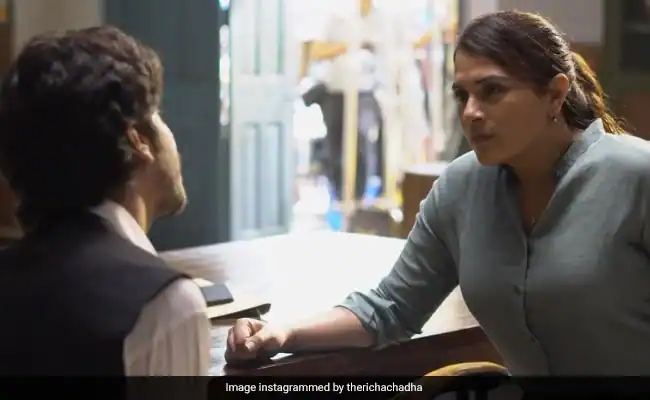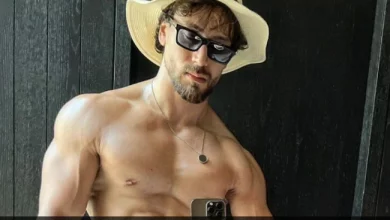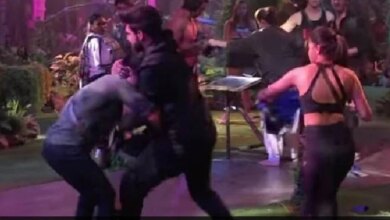The Great Indian Murder Review: Murder Mystery Isn’t Lacking In Intrigue Or Insight

[ad_1]
The Great Indian Murder Review (Courtesy: therichachadha)
A secondary character in The Great Indian Murder, produced by Ajay Devgn Films, puts the murky goings-on in perspective: “Dilli bhi toh gol-gol hain… Shaher chhahe kitna bhi bada ho bade logon ka circle hamesha chhota hi hota hai.” That line conveys the essence of writer-director Tigmanshu Dhulia’s adaptation of Vikas Swarup’s Six Suspects, a murder mystery that doubles up as a lucid commentary on India’s many implacable schisms.
The book (published over a decade ago) wasn’t exactly a novel for the ages. The Disney+Hotstar series isn’t a definitive, trailblazing story of crime and comeuppance either. But thanks to the circuitous, back-and-forth spin that Dhulia and his co-writers (Vijay Maurya and Puneet Sharma) put on the freewheeling reworking of the story for the screen, The Great Indian Murder isn’t wanting in either intrigue or insight.
Multiple plotlines are woven (not unlike the way it was in the tome) around the murder of the debauched son of a corrupt politician during a party he hosts to celebrate his acquittal in a murder case with the aid of money power and doctored evidence.
The rot in the vitals of a vast, complex and sharply divided nation is what The Great Indian Murder delves into. It alludes, if only in passing, to December 6, 1992, a day that marked the beginning of a dramatic paradigm shift in Indian politics. One key character, sitting in his home in Raipur, also talks of the future carving out of Chhattisgarh from Madhya Pradesh and exults: “Naya rajya, naya raj, naya neta.”
All hopes of renewal stay on paper. Nothing changes. With its stress firmly on continual, cynical, cussed political shenanigans, The Great Indian Murder lays bare the skulduggery, criminality, corruption and toxicity of a powerful cabal that exploits its grip on the levers of authority to mint money and prey on the dispossessed and desperate.
A Bollywood diva is one of the key figures in the Vikas Swarup novel. In the series, she is reduced to a glorified footnote. Much else is altered in The Great Indian Murder. The show sets the story not in Uttar Pradesh but in Chhattisgarh and traverses the length and breadth of the country – Raipur, Kolkata, Chennai, the Andaman Islands and small towns in Jharkhand and Rajasthan – in search of clues.
Vicky Rai (Jatin Goswami) is bumped off in the opening episode but his shadow and the bullet that cuts short his life necessarily looms large over the whodunit and drives the nine-episode narrative backwards as the motives and histories of the guests are divulged.
The gripping screen adaptation retains the kernel of the plot but brings in angles and characters that effect sweeping changes in the structure and emphasis of the text. For one, the series employs two investigators – Delhi Crime Branch DCP Sudha Bharadwaj (Richa Chadha) and CBI officer Suraj Yadav (Pratik Gandhi) – as conduits for grasping the string of events that lead to murder.
Sudha and Suraj’s interrogations yield conflicting contexts. The list of murder suspects swells as the many plotlines are revealed. Everybody at the Chhatarpur farmhouse party, including Vicky’s father Jagannath Rai (Ashutosh Rana), are under the scanner. Interestingly, neither of the two sleuths, who constantly work at cross-purposes, are anything but morally spotless.
Most of the key players in The Great Indian Murder are introduced in Episode 1 itself – a few of them at some length, the others as mere flashes – but it isn’t until the show is well into its final chapter that the guessing game ends. Along the way, the script adds larger political and existential layers to a story of sleaze and subterfuge, deceit and depravity.
Nobody among the principal characters in The Great Indian Murder, barring an ‘outsider’ (he is as far from the world of the power wielders and brokers as one can be) and a young woman who is a prisoner in her own gilded but putrid home is incorruptible. Everybody has a massive axe to grind.
The axes vary significantly in size and potency, but the ways of the men and women orbiting around Vicky Rai – who is by far the vilest of them all and many people, associates and adversaries alike, have a reason to wish him dead – are equally down and dirty.
The Great Indian Murder, like Six Suspects, is an examination of the decrepit moral core that defines the world that Vicky Rai, his father, one-time home minister of Chhattisgarh, and others of their ilk – such as the unscrupulous Delhi politician Ambika Prasad (Vineet Kumar) – inhabit.
The tale has many skeins tucked into a dense construct. To begin with, the series is a close-up ‘image’ of the murder of Vicky Rai. It zooms out progressively to provide a wider view of the focal area and its surroundings to piece together crucial details of acts of omission and commission around the stage as each of the suspects, grilled by either Sudha or Suraj, recalls what transpired on the fateful night.
No tears are shed when Vicky Rai dies. Many have a motive to kill him, but the weakest – a small-time crook (Shashank Arora) from a Delhi slum cluster and an Andaman man (Mani P.R.) who has sneaked into the party looking for an idol stolen from his tribe – are taken into custody.
Besides the bereaved father, whose sights are set on the CM’s seat, a Bollywood actress (Paoli Dam), who has a score to settle with Vicky, and Vicky’s half-sister (Rucha Inamdar), the party is attended by schizophrenic ex-bureaucrat Mohan Kumar (Raghubir Yadav), who is under the delusion that he is a modern-day Mahatma Gandhi. The needle of suspicion also points to the state chief minister (Kenneth Desai).
A welfare officer Ashok Rajput (Sharib Hashmi) enters the scene much later in the show and stands by the tribal who grapples with a huge language barrier but uses his native intelligence to find his way around in an alien, hostile environment.
The huge gallery of characters, locations and impulses ensures a wide range of conflicts within and outside Vicky Rai’s coterie, but the principal point of view belongs to the screenwriters and the camera (handled by Rishi Punjabi). As they drill deeper into the messy trail left behind by Vicky Rai, each flashback, like a peeled-off onion rind, reveals a little more than the last until the final big twist completes the story.
Richa Chadha gets her first speaking lines only in Episode 3 and Pratik Gandhi does not make his entry until the final moments of Episode 2 but the two actors, along with Ashutosh Rana and Raghubir Yadav, dominate the show.
Equally noteworthy are the performances of actors with far less screen time – Sharib Hashmi, Shashank Arora, Amey Wagh and Rucha Inamdar. Especially remarkable are Mani P.R. and Vineet Kumar, playing two characters who represent opposite ends of the social spectrum, one hapless and silent, the other mealy-mouthed and ruthless.
The Great Indian Murder squeezes just enough life out a sudden death to last the distance. It serves up homicide and home truths with some effort to spare. Watchable all the way.
[ad_2]
Source link






